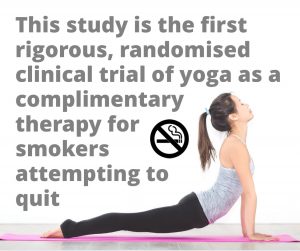Yoga May Aid Smoking Cessation Efforts
Use of yoga, along with cognitive-behavioral therapy (CBT), may help improve smoking cessation efforts, new research suggests.
A randomized controlled trial of more than 200 adult smokers showed that those who took part in an 8-week program of smoking-focused cognitive-behavioral therapy CBT and twice-a-week sessions of Iyengar yoga had 37% greater odds of achieving smoking abstinence at end of treatment (EOT) than those who underwent cognitive-behavioral therapy plus general wellness classes.
Interestingly, members of the yoga group who were considered “heavy smokers” at baseline were more likely to cut down on their use of cigarettes by end of treatment, whereas “light smokers” were more than twice as likely to quit smoking compared with light smokers in the wellness group.
In addition, each yoga class that was attended increased the odds of smoking cessation at end of treatment by 12%. However, the effects were no longer significant after the treatment program stopped, as shown at 3- and 6-month follow-up visits.
“We were a little surprised that the effect wasn’t as strong as we’d hoped. It didn’t really last through follow-up,” lead author Beth C. Bock, PhD, professor of psychiatry and human behavior at Brown University Medical School, Providence, Rhode Island, told Medscape Medical News.
“We didn’t see a significant group difference on the long term, only the short term. I suspect many people did not continue practicing yoga once the program was over, which might be why the effect didn’t last. With any exercise, the effect only lasts as long as you do it,” Bock said.
The findings were published online October 6 in Nicotine and Tobacco Research.
First Trial of Its Kind
“Yoga has been shown to reduce stress and negative mood and may aid in weight control, all of which have proven to be barriers to quitting smoking,” write the investigators.
“This study is the first rigorous, randomized clinical trial of yoga as a complementary therapy for smokers attempting to quit,” they add.
A total of 227 adult smokers (55.5% women; mean age, 46.2 years) were randomly assigned to undergo either 1-hour, twice-weekly Iyengar yoga classes (n = 113) or general wellness classes (n = 114) for 8 weeks. Both groups also participated in weekly, 1-hour sessions of group-based cognitive-behavioral smoking cessation.
The nonvigorous yoga classes emphasized back alignment and use of props, such as blocks and straps, in order to reduce risk for injury. “Classes included 5 minutes of pranayama, 45 minutes of dynamically linked asanas, and 5 -10 minutes of resting meditation,” the investigators write. In addition, weekly handouts were given to the participants so that they could practice at home between sessions.
In the group wellness classes, the participants listened to lectures and watched health-related videos and demonstrations. A discussion with a healthcare professional followed these activities.
cognitive-behavioral therapy for smoking cessation included activities such as the handling of smoking triggers, managing withdrawals, and discussing plans for the targeted quit day.
The mean smoking rate at baseline for the entire study group was 17 cigarettes per day. In order to isolate the effects of yoga, no medications were used to help with smoking cessation.
Measurements included cotinine-verified 7-day point prevalence abstinence at week 8, as well as at 3- and 6-month follow-ups. The total study retention rate through final follow-up was 94.7%.
Significant Group, Dose Effects
Longitudinal adjusted models showed significant group effects at EOT for those participating in the yoga classes (odds ratio [OR], 1.37; 95% confidence interval [CI], 1.07 – 2.79).
In addition, a “significant dose effect was observed” for yoga but not wellness (OR, 1.12; 95% CI, 1.09 – 1.26), the researchers report.
However, in the full group, only 11.2% demonstrated prolonged smoking abstinence at final follow-up, and there was no significant group effect at that time (P = .92).
At end of treatment, the yoga participants were smoking significantly fewer cigarettes per day than were the wellness participants (difference, 1.54; P = .01). In addition, among the participants who smoked at least 20 cigarettes per day at baseline, those in the yoga group smoked 2.66 fewer cigarettes per day at end of treatment than those in the wellness group (P = .04).
For the yoga group members who smoked 10 or fewer cigarettes per day at baseline, the likelihood of having quit at end of treatment was significantly greater than for the members of the wellness group (OR, 2.43; 95% CI, 1.09 – 6.30).
However, “there were no moderating effects of baseline smoking rate on continuous abstinence,” write the investigators.
Bock reiterated that some of this could have been caused by many of the yoga group members stopping or greatly reducing their home yoga practice after the group classes ended.
Among the group, 47% reported practicing yoga in their homes an average of 2.56 days per week at end of treatment. The average was only 90 minutes per week at 3 months and only 75.36 minutes per week at 6 months.
“This was a fairly intensive protocol; and it’s hard to go from that to going home and finding a program on your own to continue,” Bock said.
The investigators also found four distinct patterns of quitting behavior. The yoga group was more likely to be able to quit on the week-3 designated quit day or to gradually reduce their smoking rate, leading to full abstinence by end of treatment, than the wellness group (P = .04). Both are considered to be “successful” quitting patterns.
The wellness group was more likely to quit before the designated quit day but then relapse before end of treatment or never achieve full abstinence.
There were no differences in smoking cessation effects between the men and women.
More Research Needed
Overall, the study “adds to our knowledge of the types of physical activity that aid smoking cessation,” write the investigators.
“Yoga appears to increase the odds of successful smoking abstinence, particularly among light smokers,” they add.
They also reiterated that there was a strong dose-response effect.
However, more research is needed “to identify predictors of quitting patterns and inform adjustments to therapy needed to achieve cessation and prevent relapse,” the researchers note.
Bock noted that if a clinician is considering recommending that a smoker try yoga, a gentle version geared toward beginners might be the way to go. She noted the importance of “checking in” to make sure the patient is following through with a yoga program.
“Our participants said that one of the things they liked about our program is that it was geared towards people who were quitting smoking. However, going to a yoga class out in the public was somewhat intimidating because the typical yoga student was very different from what they were, in terms of age and physical fitness,” she said.
“Evidence-Based Effects”
Asked to comment on the study by Medscape Medical News, Scott McIntosh, PhD, associate professor, Department of Public Health Sciences, University of Rochester Medical Center, New York, noted that although the study didn’t show long-term benefit from yoga, “there was a really good evidence-based effect for smoking cessation” for the therapy at end of treatment.
“They provided strong evidence on short-term quitting success and a dose effect. So people who got more yoga were more likely to quit compared to those who got the wellness therapy,” said McIntosh, who was not involved with the research.
“This will add to the literature. People will learn from this and, as the authors suggest, explore what more that yoga can do to affect patterns of quitting. Obviously, we also need to explore what can lead to better long-term abstinence at 3, 6, and even 12 months,” he added.
McIntosh is also the associate director of the Smoking Research Program at the University of Rochester and director of the Center for a Tobacco-Free Finger Lakes.
He added that there’s no downside for clinicians recommending that patients try yoga, “as long as they are healthy enough for it.
“Physicians could point out that it’s helpful. And it could, of course, be combined with other successful smoking cessation strategies, such as the very intensive 8-week group therapy that the authors used, or other talk therapy, or medications,” McIntosh said.
He also noted that clinicians should consider recommending that patients use 1-800-Quit-Now, a telephone support line, or the website SmokeFree.gov <https://smokefree.gov/> for online, interactive help.
The study was funded by a grant from the National Center for Complementary and Integrative Health, the National Institutes of Health. The study authors and Dr McIntosh have reported no relevant financial relationships.
References
Nicotine Tob Res. Published online October 6, 2018. Abstract
<https://academic.oup.com/ntr/advance-article abstract/doi/10.1093/ntr/nty21
2/5122859?redirectedFrom=fulltext>
Medscape Medical News C 2018
Cite this article: Yoga May Aid Smoking Cessation Efforts – Medscape – Oct 22, 2018.
Yoga May Aid Smoking Cessation Efforts – Deborah Brauser October 22,
Dr Beth Bock, Dr Scott McIntosh
Artwork Created in Canva


Recent Comments